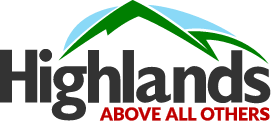Customer and Employee Centered

Customer and Employee Centered
The Customer is in the Room…and other News from Highlands
Sometimes, to know what a company IS NOT is as telling as to know what a company IS. So, in this post, you will learn what you will NOT find at Highlands, as well as some things that you most certainly will. Let’s hit on some key points to shed light on our company’s culture, work processes and other telling indicators. In the spirit of full disclosure, let’s drill into the working machinery of Highlands.
NOT a corporation that snubs the customer
Say “hello” to the customer. She (or he) is at the scrum meeting. Well, not literally. If you want to visualize the customer looming over the conference table or hovering, phantom-like, during a scrum meeting, go ahead. It is not far from reality. But you will be hard pressed to find a software company that is more eager to please the customer. Soliciting—and acting on—customer feedback is as important as any other task that Highlands does. In fact, while most companies are satisfied to keep only minimum records of existing customers—contact name, billing address—that would never do for Highlands. We got the sale, yes, but our commitment to our customers doesn’t end there. We want to be sure that our software continues to deliver and perform well after the deal goes through.
Our team gathers customer feedback constantly. How is this done? Customer Support Representatives call customers every 2 to 3 months to check-in and get updates on how the software is performing. We want to know what is working, what isn’t, and what we need to change. In the process of fielding inbound calls, tech support engineers gather information as well. If we don’t understand a client’s issue, we use any technology available, from video recorded calls to client demos, to truly understand what a client needs and wants from the software. Now and then, the Engineering Director gets on the phone to make a “discovery call” and uncover precisely what a customer is looking for in our software. How many companies do you know of that do this? (We call this “software features on demand”). Information from our clients is meticulously documented and factored into the process of product development, as we will discuss in the paragraphs below.
NO stagnation here: Employees Evolve… as does the Company
Human Resources is probably one of the most important departments in our shop. Why is this so? Because equal in importance to our customers—if not more so—are the people that work at Highlands. These are the folks behind the core machinery at Highlands. Without them, we would not produce anything of value. So, we invest as much in our employees as we do in our product. We hope that employees take advantage of the many training and advancement opportunities that Highlands offers to grow and evolve.
But here’s something you may not recognize: A company needs to evolve and grow with its employees. If you consider Highlands your work “home”, you will want the team at Highlands, and the processes and systems that make it all come together, to work, evolve and grow stronger too. Ideas to make the community and the systems stronger at Highlands are always welcome.
Not a Coding “Mill”
How much code did you write today? This is NOT a question you will hear from any of us. Management cares about developers. We are not in the business of extracting blood and sweat. We expect hard work and our performance standards are high, but above all, we are fair. We will work with you, not against you. You are one of us—remember?
We believe in the magic and power of teams. You won’t be asked to learn the job on your own or figure out problems in isolation. We pair you up with another programmer to help you become familiar with our processes. A culture of teamwork and partnership forms the backbone of work at Highlands. We are a tight group that is interdependent, supportive of one another, and motivated to produce the best product possible under the best working conditions possible.
No Stuffed Shirts Here: Software Development as quick to Adapt as the Company itself
How good would we be as developers of leading-edge engineering software if we couldn’t change course quickly and respond to client needs? We wouldn’t last long. So not only are we quick to address the people side of things—the team and workplace issues, but we are agile and fluid when it comes to our product too. In fact, evolutionary ideals shape everything we do at Highlands. We take an iterative tack with respect to software design. If in the process of shaping our MVP (minimum viable product) we realize we are off track on core features, we don’t waste time. On a daily basis, the Highlands routine goes something like this: scrum meeting, write code in pairs or teams (ask questions), assess progress and check goals (ask questions), work, repeat tomorrow (and ask more questions).
Final question: Is the Highlands team a bunch of arrogant know-it-alls who can’t stand to be corrected or told that they are wrong?! No. We know change and growth is good. We also like to think we are a humble bunch of folks who just want to make good—actually really good—engineering software and to have some fun doing it. We hope you’ll consider joining us.






